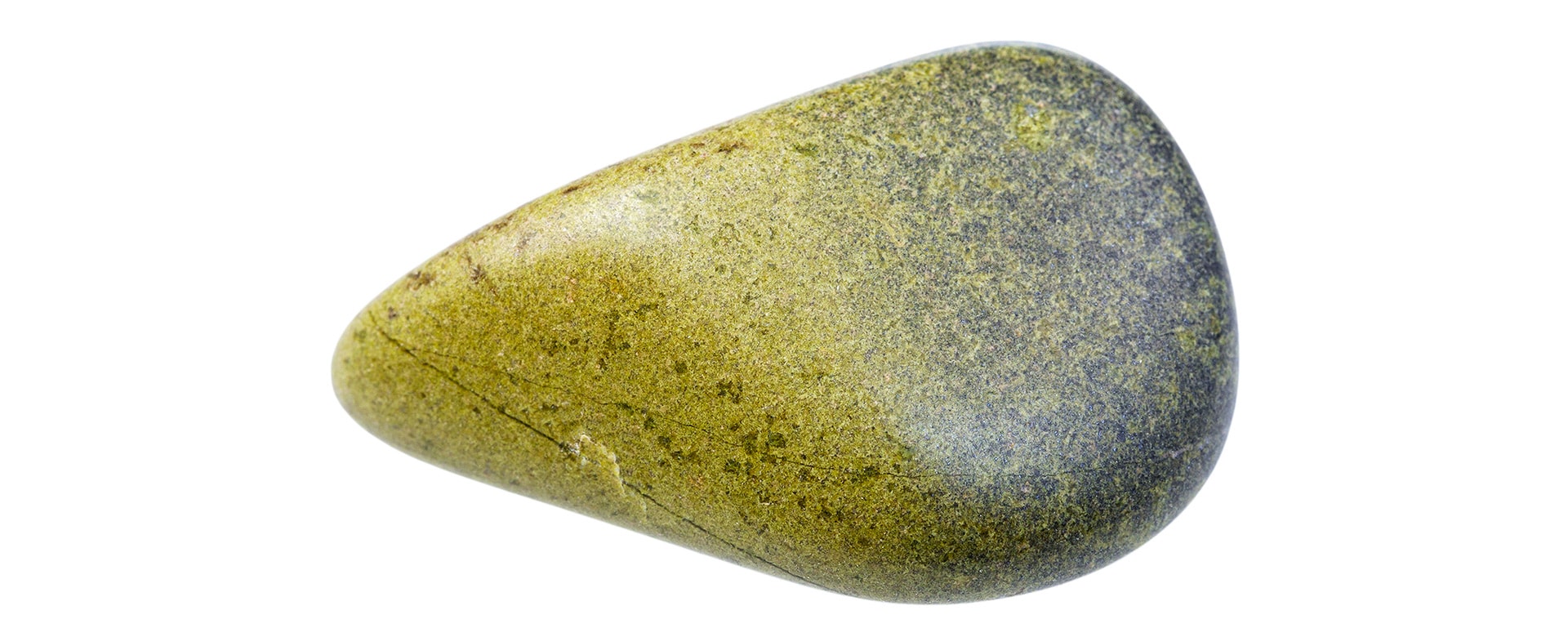Article Highlights
Epidote is a captivating gemstone with a dual personality in the realm of mineralogy! On one hand, the term “Epidote Group” refers to a family of silicate minerals with shared structural and compositional traits. On the other, “Epidote” itself is the star of this group, known for its unique properties and widespread presence. This intriguing mineral isn’t just a geological wonder; it’s a treasure trove of mystery and allure waiting to be explored.
Physical Properties of Epidote

Chemical Classification and Composition
Epidote dazzles with its complexity and charm! Belonging to the silicate class, its chemical composition, Ca2(Al2,Fe)(SiO4)(Si2O7)O(OH), reveals a harmonious blend of calcium, aluminum, iron, silicon, and oxygen. This intricate formula contributes to its remarkable characteristics and diverse appearance, making it a standout in the mineral world.
Color, Streak, and Luster

Imagine a spectrum of colors from yellowish-green to pistachio green, and sometimes even a mysterious brownish-green to black. That’s the color palette of Epidote, an artist’s dream! Its streak is colorless, leaving no trace of its vivid hue behind. The luster of Epidote ranges from vitreous, resembling the sparkle of glass, to resinous, giving it an organic, earthy glow. This interplay of color and light makes each piece of Epidote a unique work of art.
Diaphaneity, Cleavage, and Hardness

Epidote is a master of disguise, ranging from transparent to nearly opaque. Its diaphaneity plays with light, revealing hidden depths and secrets within. Its cleavage is perfect in one direction, showcasing its natural tendency to break along beautiful, flat surfaces. With a Mohs Hardness of 6 to 7, Epidote is resilient, standing the test of time and the elements. This combination of transparency, cleavage, and hardness makes Epidote not just a stone, but a symbol of endurance and mystery.
Specific Gravity and Diagnostic Properties
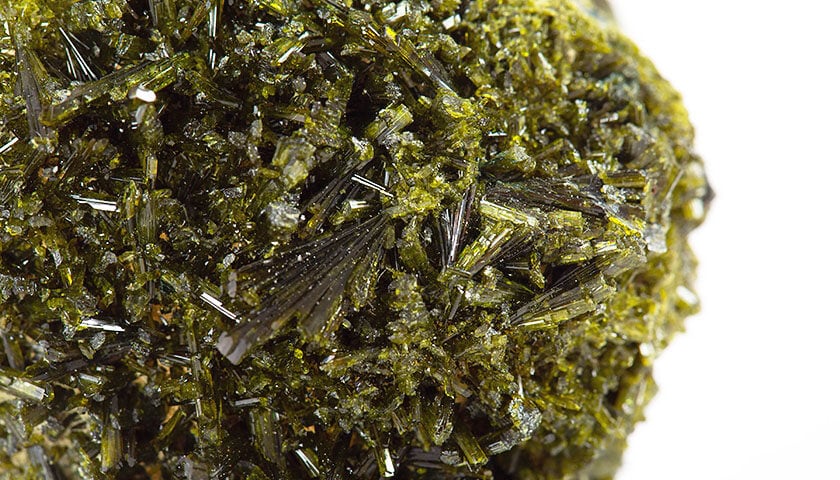
Epidote has a specific gravity of 3.3 to 3.5, giving it a substantial feel that’s as weighty and significant as its appearance. Its diagnostic properties, like color, cleavage, and specific gravity, are like fingerprints, each piece telling its own story. The crystal system of Epidote, monoclinic, speaks to its complex and symmetrical beauty. Together, these features create a mineral that’s not only fascinating to study but also a delight to behold.
Epidote as a Mineral
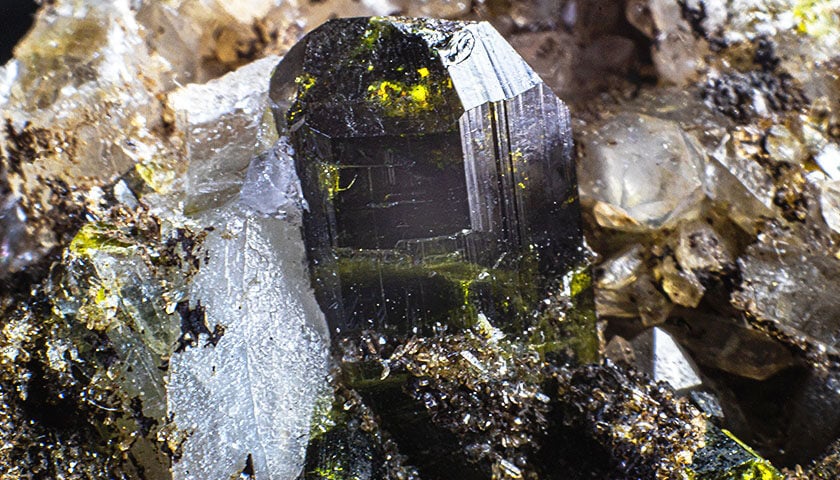
Epidote is a storyteller, narrating tales of the earth’s transformations. Commonly found in regionally metamorphosed rocks of low-to-moderate grade, it whispers the secrets of the stones it accompanies, like amphiboles, feldspars, quartz, and chlorite. This mineral is a shape-shifter, appearing as replacements in altered mineral grains, in veins cutting through granite, and as stunning monoclinic crystals in pegmatites. Its presence in marbles and schists, altered through contact metamorphism, speaks of its journey through heat and pressure.
A Symphony of Colors and Forms
From yellowish-green to pistachio, and sometimes even deep, earthy browns and blacks, Epidote’s color range is a visual feast. In its massive form, it’s usually translucent, holding the light in a soft, vitreous embrace. The well-formed crystals found in marble and pegmatite are often transparent, windows into the depths of the earth. Each piece of Epidote is a chapter in a larger story, a story of change, resilience, and beauty.
Chemical Composition and Solid Solution Series
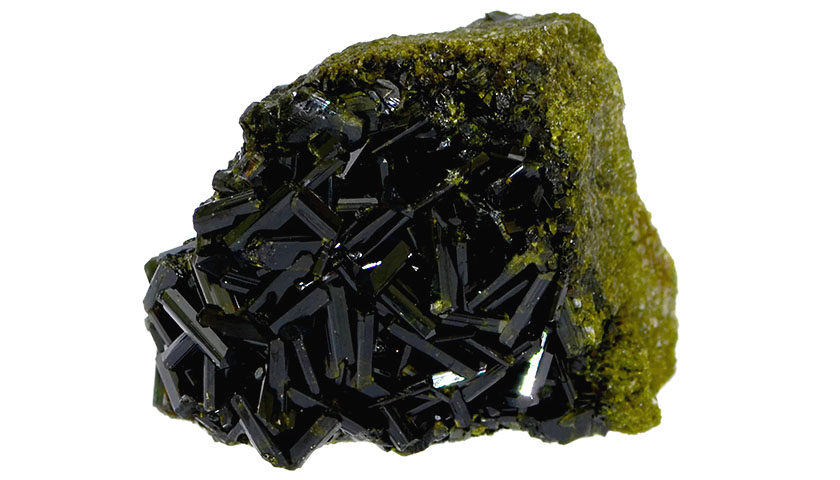
At the heart of Epidote is its chemical composition, a testament to nature’s ability to create diversity from simplicity. As an end member of a solid solution series with clinozoisite, Epidote’s iron gradually gives way to aluminum, shifting from the deep greens of Epidote to the lighter hues of clinozoisite. This transition is not just a chemical change; it’s a visual journey, with iron responsible for Epidote’s signature greenish to brownish colors. Each piece of Epidote is a snapshot of this journey, a moment frozen in time, waiting to be discovered and appreciated.
Notable Varieties and Forms of Epidote
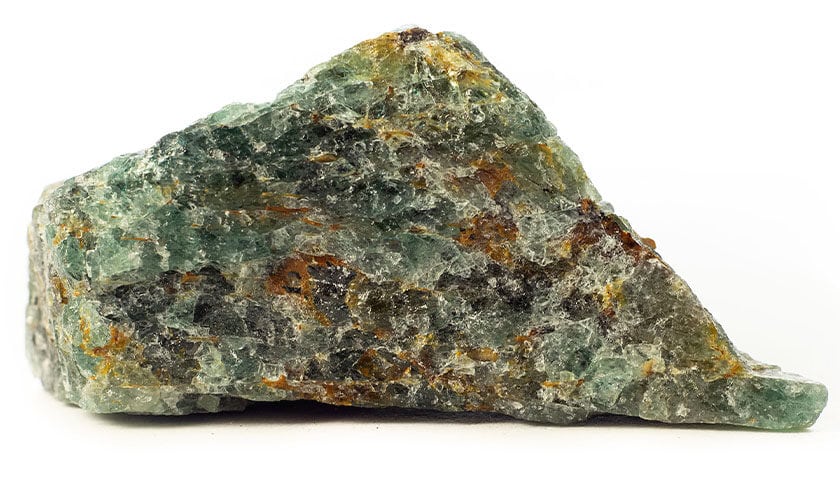
Epidote and Piemontite
Delve into the vibrant world of “Dragon Blood” or “Dragon Stone,” a mesmerizing blend of Epidote and Piemontite. These tumbled stones are more than mere minerals; they’re a symphony of deep greens and enchanting reds, each piece telling a story of geological wonder. The presence of Piemontite adds a touch of magic to the mix, with its reddish hues complementing Epidote’s green, creating stones that are as visually striking as they are geologically significant.
Epidote Crystals
Behold the splendor of Epidote crystals from Rockbridge County, Virginia. These natural sculptures, approximately 4 inches across, are a testament to the beauty and complexity of the mineral world. Each crystal is a prism of geological history, its facets and forms reflecting the conditions under which it was formed. The luster and depth of these crystals make them not just objects of scientific interest, but also of artistic admiration.
Epidote in Unakite
Explore the world of Unakite, an igneous rock composed mainly of green Epidote, pink orthoclase feldspar, and clear quartz. This unique combination gives Unakite its distinctive, mottled appearance, a natural mosaic of color and texture. Tumbled stones made from South African Unakite showcase the harmonious blend of these minerals, creating pieces that are as beautiful as they are unique. The presence of Epidote in Unakite not only contributes to its green coloration but also adds to the stone’s overall metaphysical properties.
Epidote in Rocks

Epidote doesn’t just exist in isolation; it’s a vital part of the rock-forming process, adding color and character to a variety of geological formations. Let’s explore two rock types where Epidote plays a starring role: epidosite and unakite.
Epidosite
Journey into the world of Epidosite, a metamorphic rock primarily composed of Epidote with hints of quartz. This rock is born from the transformation of basalts in sheeted dikes and ophiolites, a process driven by hydrothermal activity or metasomatism. The resulting rock is a testament to the dynamic nature of the earth’s crust, a record of the changes wrought by heat, water, and pressure.
Unakite
Discover Unakite, a fascinating rock that forms from the metamorphism of granite. In this process, less-resistant minerals in the granite are altered to or replaced by Epidote, while orthoclase and quartz remain largely unchanged. The result is a visually striking rock, with a unique combination of pink and green colors that first caught the eye in the Unakas Mountains of North Carolina. Unakite isn’t just a geological curiosity; it’s a piece of natural art, its colors and patterns telling a story of change and endurance.
Uses of Epidote

While Epidote might not be the most famous gemstone, its uses and appeal are as unique as the mineral itself.
As a Gemstone
Epidote’s role as a gemstone is modest but meaningful. Transparent crystals of high quality are sometimes cut into faceted stones, treasures that are more likely to end up in the collections of gem enthusiasts than in commercial jewelry. The reason might be the unique, not universally popular color of Epidote. However, for those who appreciate its deep, complex green, a faceted Epidote is a rare and valuable find.
In Lapidary and Ornamental Uses
Unakite, with its distinctive pink and green coloration, has won a place in the hearts of lapidaries and collectors alike. Used to make beads, ornamental objects, and cabochons, Unakite’s appeal lies in its unusual and eye-catching color combination. As a tumbled stone, it’s particularly popular, with the bright pink and pistachio green colors drawing attention wherever they’re displayed. A small amount of Epidosite is also cut into cabochons, highlighting the beauty and versatility of Epidote in its various forms.
Epidote Meaning & History
Epidote is more than just a mineral; it’s a symbol of manifestation, karma, and personal growth. Known as the “attraction stone” in spiritual circles, Epidote is believed to amplify the energies you emit, encouraging a cycle of positivity and growth.

Symbolism and Spiritual Beliefs
In the realm of spirituality, Epidote is a stone of awakening. It’s said to help you manifest what you desire and, at the same time, understand the consequences of your actions. By reflecting your own energies back to you, Epidote can be a tool for personal insight and development, a mirror to the soul.
Historical Context and Mythology
The name “Epidote” is derived from the Greek word ‘epidosis,’ meaning ‘increase’ or ‘addition.’ This refers to the way prismatic Epidote crystals often have one side longer than the other, but it could also symbolize the stone’s ability to increase whatever it touches, whether that’s energy, emotion, or understanding. In Greek mythology, Epidotes was a spirit of abundance and generosity, a fitting namesake for a stone that’s all about giving and receiving.
René Just Haüy and the Naming of Epidote
The story of Epidote’s discovery and naming is intertwined with that of René Just Haüy, the famed French mineralogist. His work laid the foundation for modern mineralogy, and in naming Epidote, he added another chapter to the rich and fascinating history of this stone. The name, the history, and the legend all combine to make Epidote a mineral with a story as complex and intriguing as its appearance.
Epidote Healing Properties
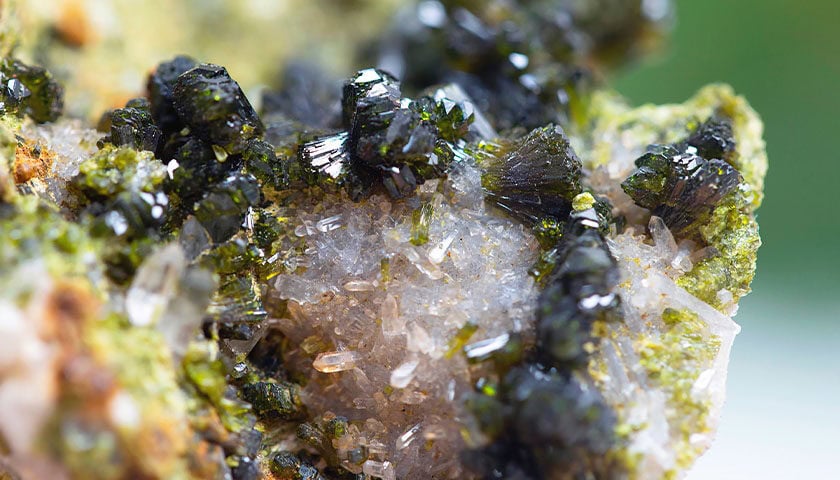
Epidote, with its rich, green hues and complex structure, is more than just a visually striking mineral. It’s believed to possess a wide array of healing properties that can benefit the body, mind, and spirit. Whether you’re a seasoned crystal healer or simply curious about the potential benefits of this unique stone, exploring the healing properties of Epidote can be a fascinating journey.
Physical Healing
Epidote is often turned to for its supposed physical healing powers. Advocates believe that it can:
- Purify the Body: Epidote is said to help release negativity and raise one’s vibrational energy, potentially leading to a more balanced and purified physical state.
- Improve Memory: Some users turn to Epidote when seeking to clear mental fog and improve memory and concentration.
- Increase Endurance: By imbuing its wearer with energy, Epidote is thought to boost stamina and physical strength.
- Ease Tension: The calming nature of the stone is believed to help alleviate physical tension and stress.
- Strengthen the Immune System: Epidote’s energizing properties might also extend to bolstering the body’s defenses.
- Boost Blood Circulation: The stone is thought to encourage a healthy flow of energy, which can translate to improved circulation.
Emotional Healing
Epidote’s impact is said to extend well into the emotional realm, where it is believed to:
- Enhance Creativity: By clearing away emotional blockages, Epidote can pave the way for a surge of creativity and inspiration.
- Attract Abundance and Prosperity: Often referred to as the “stone of increase,” Epidote is believed to magnify the positive aspects of one’s life, including wealth and opportunities.
- Promote Romantic Love: Its ability to amplify energies can include enhancing feelings of love and passion.
- Facilitate Self-Understanding: Epidote encourages reflection and introspection, helping individuals understand their deepest desires and motivations.
- Surface Repressed Feelings: By bringing hidden emotions to the forefront, Epidote can help individuals address and heal from past traumas.
- Enhance Communication: The stone is said to aid in expressing feelings more clearly and effectively.
Chakra Healing
Epidote’s green color aligns it closely with the heart chakra, the center of compassion, empathy, love, and forgiveness. When used for chakra healing, Epidote is believed to:
- Open the Heart Chakra: By removing energy blockages, Epidote can help open up the heart chakra, allowing love and healing to flow freely.
- Encourage Compassion and Understanding: With a balanced heart chakra, individuals may find themselves more understanding and empathetic towards others.
- Facilitate Acceptance: Epidote can help one accept and love themselves, fostering a sense of inner peace and contentment.
Using Epidote for Healing
To harness the healing properties of Epidote, individuals often carry the stone with them, wear it as jewelry, or place it in their living or working space. Meditating with Epidote is also common, as is placing it directly on the body or the chakra points during healing sessions. As with all types of crystal healing, the key is intention and belief in the stone’s power to amplify and enhance positive energy.
A Note of Caution
While many believe in the healing properties of Epidote, it’s important to remember that these should not replace professional medical advice or treatment. Crystal healing is best used as a complementary practice, one that can enhance well-being and support other health and wellness efforts.
Epidote Gemstone Properties
Epidote is a versatile and complex gemstone, appreciated not just for its distinctive color but also for its unique properties. When considering Epidote for jewelry or collection, various factors contribute to its appeal and value.
Color
Epidote’s color spectrum is a significant aspect of its charm. It typically ranges from a deep, yellowish-green to a pistachio green, and sometimes even to a dark green or black. The most desirable shades are the classic pistachio or yellow-green hues. Lighter colors are often more valued as they tend to display the stone’s transparency and pleochroism (an optical phenomenon where the stone appears to be different colors when observed at different angles) more vividly. The presence of iron impurities lends Epidote its green to brown color, while more aluminum results in lighter shades.
Cut
The cut of an Epidote gemstone plays a crucial role in its overall appearance and value. High-quality transparent Epidote is often faceted to highlight its unique color and brilliance. Common cuts include octagons, ovals, and cushions, with more intricate shapes like hearts or trillions being rarer. The lapidarist must carefully orient the stone to enhance its pleochroism and overall aesthetic appeal. Collectors also value raw, uncut Epidote when it forms long and twinned crystals with a strong glassy luster. In contrast, opaque Epidote is more typically cut as cabochons, beads, or carvings to best display its qualities.
Transparency & Luster
Epidote’s transparency can range from nearly opaque to transparent, with the most transparent material being the most prized, especially when faceted into gemstones. The luster of high-quality Epidote is vitreous, resembling the sheen of glass. In contrast, a resinous luster indicates lower quality but can still be quite beautiful and desirable depending on personal preferences.
Clarity
Clarity in Epidote refers to the presence and visibility of inclusions within the stone. While some Epidotes may have fluid or mineral inclusions like titanite and magnetite, which can affect transparency and value, others can be quite clear. It’s also common for Epidote to be an inclusion itself in other stones, like quartz or prehnite.
Carat Weight
Large, facetable pieces of Epidote are rare, making any high-quality gemstone over 5 carats particularly valuable. As the size increases, so does the rarity and, consequently, the value of the stones.
Epidote Formation & Sources

Understanding where and how Epidote forms can deepen your appreciation for this unique gemstone. It’s a product of specific geological conditions, primarily metamorphic processes.
Epidote Formation
Epidote primarily forms through two types of metamorphism: regional and contact. Regional metamorphism involves heat, often from nearby magma, altering the composition of minerals within a rock. Contact metamorphism, on the other hand, involves both heat and pressure, leading to similar changes. As a result, Epidote is commonly found in metamorphic rocks like marble, hornfels, and skarns, as well as in metamorphosed schists and limestones. Less frequently, it appears in igneous rocks like basalt or granite pegmatites.
Mining Locations
Epidote is sourced from various locations across the globe, each contributing unique characteristics to the gemstones found there. Notable sources include:
- Eastern France: Known for abundant and high-quality Epidote.
- Russia: A source of some of the finest Epidote specimens.
- Additional locations: Australia, Austria, Brazil, Canada, Czechia, England, Finland, Germany, Italy, Japan, Kenya, Madagascar, Mexico, Norway, Sri Lanka, Switzerland, Tasmania, and various states in the USA.
Epidote Price & Value

The value of Epidote can vary significantly based on several factors, including type, color, clarity, and size.
Faceted Gems
Faceted Epidote gems are the most valuable, especially those that are transparent with desirable colors. Prices can range from $20 to $200 per carat at wholesale, reflecting their rarity and demand among collectors.
Rough and Cabochons
Rough Epidote is more affordable, usually around $1 per carat at wholesale. Well-formed crystals with good color can fetch between $2 and $5 per carat. Cabochons, popular for their smooth, domed shape, and ability to highlight Epidote’s color and patterns, typically cost around $1 per carat at wholesale.
Beads and Other Forms
Epidote beads and pendants, often used in jewelry, can range from $10 to $30 each, depending on size and quality. The unique appearance and rarity of certain pieces can significantly affect their price.
Epidote Care and Maintenance
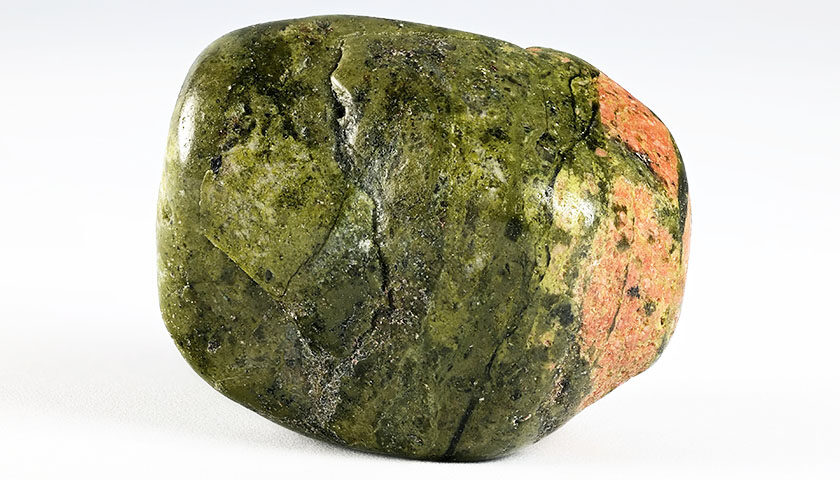
Epidote’s beauty and value make proper care and maintenance crucial. Here are some tips for keeping your Epidote gemstones and jewelry in pristine condition.
Handling and Storage
Epidote can be sensitive to pressure and impact due to its perfect cleavage. It’s best to handle it gently and store it separately in a soft pouch or lined box to prevent scratches or damage from other harder stones. Avoid exposing it to extreme temperatures or direct sunlight, which could affect its color and structural integrity.
Cleaning
Clean your Epidote with a soft, lint-free cloth. You can use mild soap and lukewarm water for a deeper clean, but avoid harsh chemicals and cleaners. Ultrasonic or steam cleaners are not recommended for Epidote due to their potential to cause damage. After cleaning, make sure the stone is thoroughly dried before storing or wearing it.
Conclusion
Epidote is a fascinating and multifaceted gemstone, offering a unique blend of beauty, rarity, and metaphysical properties. Whether you’re drawn to its vibrant color, intrigued by its geological formation, or seeking its healing properties, Epidote provides a unique and enchanting addition to any collection. With proper care and appreciation, your Epidote pieces can continue to captivate and inspire for years to come.

